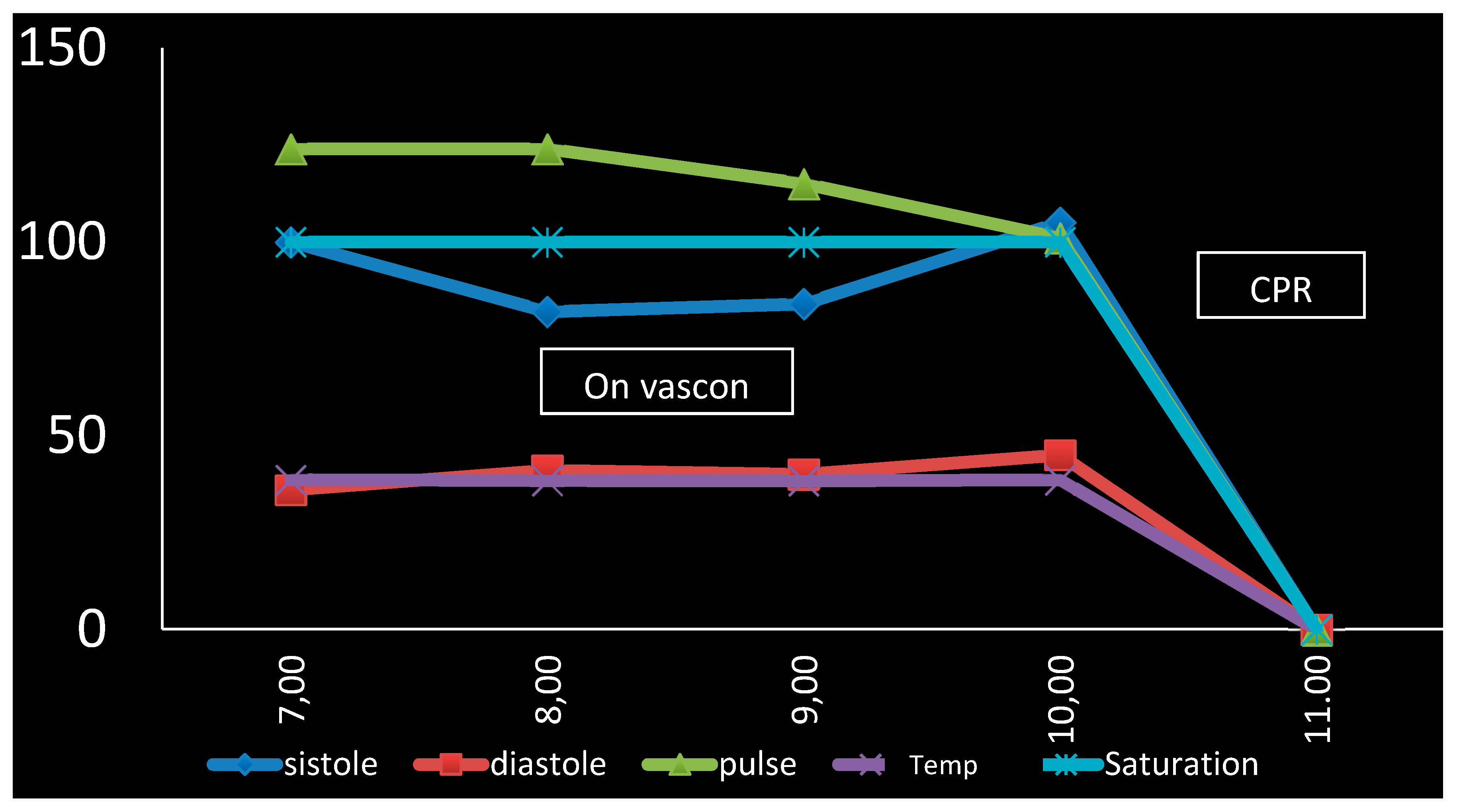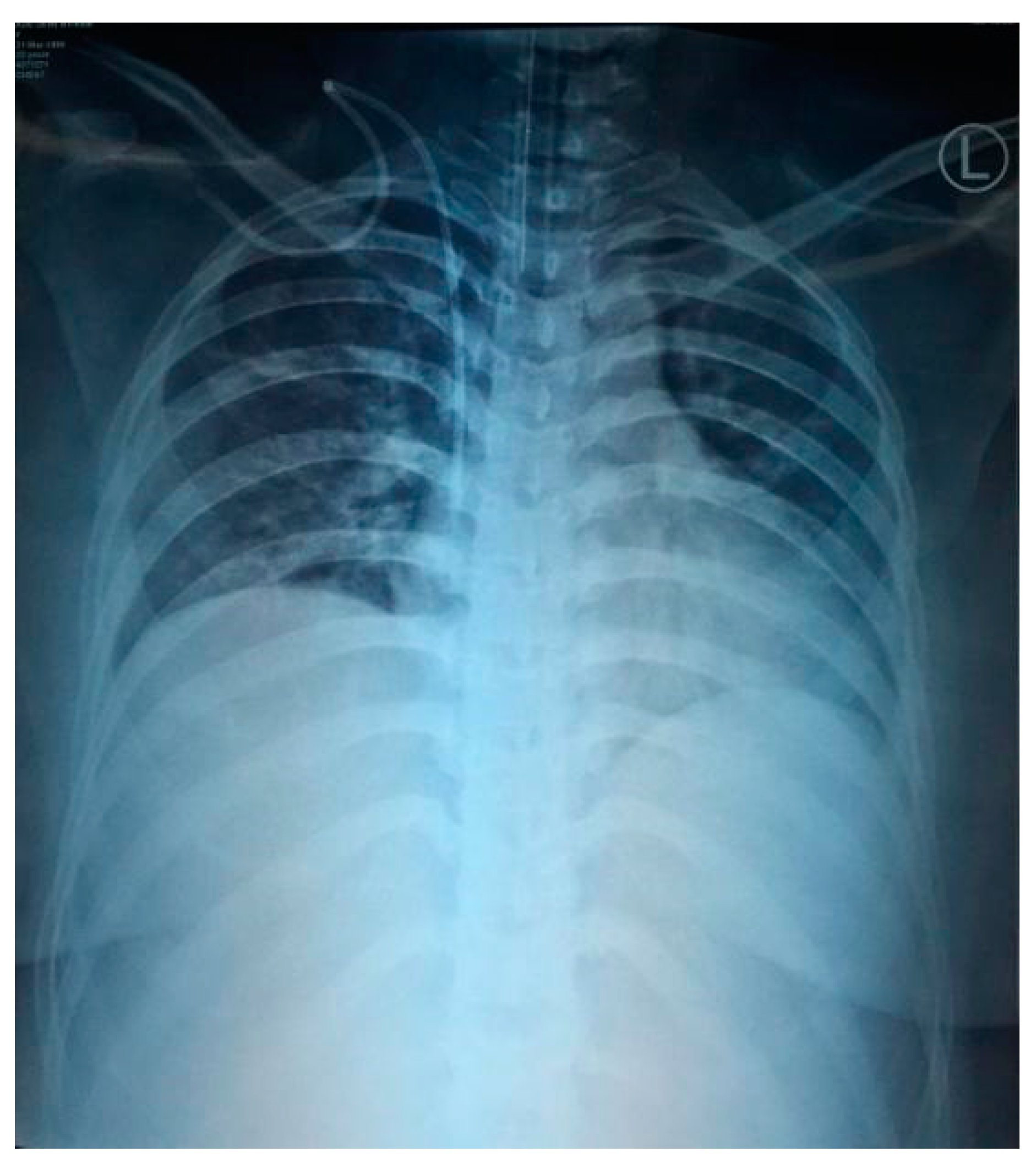Case Series of Dengue Fever in Peripartum Period: Maternal and Foetal Outcome
Abstract
1. Introduction
2. Case Illustration
2.1. Case 1
2.2. Case 2
2.3. Case 3
2.4. Case 4
3. Discussion
4. Conclusions
Author Contributions
Funding
Acknowledgments
Conflicts of Interest
References
- World Health Organization RO for S-EA. Comprehensive Guideline for Prevention and Control of Dengue and Dengue Haemorrhagic Fever, Revised and Expanded Edition; WHO Regional Office for South-East Asia: New Delhi, India, 2011. [Google Scholar]
- Karyanti, M.R.; Uiterwaal, C.; Kusriastuti, R.; Hadinegoro, S.R.; Rovers, M.; Heesterbeek, H.; Hoes, A.W.; Bruijning-Verhagen, P. The changing incidence of dengue haemorrhagic fever in Indonesia: A 45-year registry-based analysis. BMC Infect. Dis. 2014, 14, 1–7. [Google Scholar] [CrossRef] [PubMed]
- National Notifiable DIseases Surveillance System (NNDSS). Dengue Virus Infections 2015 Case Definition. CDC. Available online: https://wwwn.cdc.gov/nndss/conditions/dengue-virus-infections/case-definition/2015/ (accessed on 30 March 2020).
- World Health Organization. Dengue: Guidelines for Diagnosis, Treatment, Prevention, and Control: New Edition; World Health Organization: Geneva, Switzerland, 2009; p. 147. [Google Scholar]
- Charlier, C.; Beaudoin, M.-C.; Couderc, T.; Lortholary, O.; Lecuit, M. Arboviruses and pregnancy: Maternal, fetal, and neonatal effects. Lancet Child Adolesc. Health 2017, 1, 134–146. [Google Scholar] [CrossRef]
- Agrwal, P.; Garg, R.; Srivastava, S.; Verma, U.; Rani, R. Pregnancy Outcome in Women with Dengue Infection in Northern India. Indian J. Clin. Pract. 2014, 24, 1053–1056. [Google Scholar]
- Kariyawasam, S.; Senanayake, H. Dengue infections during pregnancy: Case series from a tertiary care hospital in Sri Lanka. J. Infect. Dev. Ctries. 2010, 4, 767–775. [Google Scholar] [CrossRef] [PubMed]
- Sharma, S.; Jain, S.; Rajaram, S. Spectrum of Maternofetal Outcomes during Dengue Infection in Pregnancy: An Insight. Infect. Dis. Obstet Gynecol. 2016, 16, 1–4. [Google Scholar] [CrossRef] [PubMed]
- WHO. Handbook for Clinical Management of Dengue. Available online: https://www.who.int/denguecontrol/9789241504713/en/ (accessed on 3 April 2020).
- Costantine, M.M. Physiologic and Pharmacokinetic Changes in Pregnancy. Front. Pharmacol. 2014, 3, 5. Available online: https://www.ncbi.nlm.nih.gov/pmc/articles/PMC3982119/ (accessed on 3 April 2020). [CrossRef] [PubMed]
- Hariyanto, H.; Yahya, C.Q.; Wibowo, P.; Tampubolon, O.E. Management of severe dengue hemorrhagic fever and bleeding complications in a primigravida patient: A case report. J. Med. Case Rep. 2016, 10, 357. Available online: https://www.ncbi.nlm.nih.gov/pmc/articles/PMC5175310/ (accessed on 3 April 2020). [CrossRef] [PubMed]
- Martina, B.E.E.; Koraka, P.; Osterhaus, A.D.M.E. Dengue virus pathogenesis: An integrated view. Clin. Microbiol. Rev. 2009, 22, 564–581. [Google Scholar] [CrossRef] [PubMed]
- Sellahewa, K.H. Pathogenesis of Dengue Haemorrhagic Fever and Its Impact on Case Management. ISRN Infect. Dis. 2013, 2013, 1–6. [Google Scholar] [CrossRef]
- Ministry of Health Sri Lanka. National Guidelines on Clinical Management of Dengue Infection in Pregnancy. Available online: http://www.slchaem.lk/dengue-in-pregnancy/ (accessed on 3 April 2020).
- Committee on Practice Bulletins—Obstetrics. ACOG Practice Bulletin No. 207: Thrombocytopenia in Pregnancy. Obstet Gynecol. 2019, 133, e181. [Google Scholar]
- Kaur, P.; Kaur, G. Transfusion support in patients with dengue fever. Int. J. Appl. Basic Med. Res. 2014, 4 (Suppl. 1), S8–S12. [Google Scholar] [CrossRef] [PubMed]
- de Azeredo, E.L.; Monteiro, R.Q.; de-Oliveira Pinto, L.M. Thrombocytopenia in Dengue: Interrelationship between Virus and the Imbalance between Coagulation and Fibrinolysis and Inflammatory Mediators. Mediat. Inflamm. 2015, 2015, 313842. [Google Scholar] [CrossRef] [PubMed]
- Hung, L.P.; Nghi, T.D.; Anh, N.H.; Van Hieu, M.; Luan, N.T.; Long, N.P.; Thach, T.T. Case Report: Postpartum hemorrhage associated with Dengue with warning signs in a term pregnancy and delivery. F1000Research 2015, 4, 1483. Available online: https://www.ncbi.nlm.nih.gov/pmc/articles/PMC4712770/ (accessed on 3 April 2020). [CrossRef] [PubMed]
- Basurko, C.; Carles, G.; Youssef, M.; Guindi, W.E.L. Maternal and fetal consequences of dengue fever during pregnancy. Eur. J. Obstet. Gynecol. Reprod. Biol. 2009, 147, 29–32. [Google Scholar] [CrossRef] [PubMed]
- Szecsi, P.B.; Jørgensen, M.; Klajnbard, A.; Andersen, M.R.; Colov, N.P.; Stender, S. Haemostatic reference intervals in pregnancy. Thromb. Haemost. 2010, 103, 718–727. [Google Scholar] [PubMed]
- Tan, P.C.; Rajasingam, G.; Devi, S.; Omar, S.Z. Dengue infection in pregnancy: Prevalence, vertical transmission, and pregnancy outcome. Obstet. Gynecol. 2008, 111, 1111–1117. [Google Scholar] [CrossRef] [PubMed]
- Khamim, K.; Khamim, B.; Pengsaa, K. Dengue Infection in Pregnancy. Southeast Asian J. Trop. Med. Public Health 2015, 46 (Suppl. 1), 153–160. [Google Scholar]
- Bopeththa, B.V.K.M.; Hemapriya, S.; Gayan Niranga, K.K.; Kotigala, D.S.K. A case report of dengue haemorrhagic fever during the peripartum period: Challenges in management and a case of vertical dengue transmission. BMC Infect Dis. 2018, 18, 427. [Google Scholar] [CrossRef] [PubMed]


| Outside | Day 1 | Day 2 | Day 3 | Day 4 | Day 5 | Day 6 | Normal Value | ||
|---|---|---|---|---|---|---|---|---|---|
| Blood count | Haemoglobin (g/dL) | 13.8 | 13.9 | 8.6 | 4.9 | 8 | 9.9 | 11.1 | 12–15 |
| Hematocrit (%) | 41 | 41.3 | 24.7 | 14.9 | 22.8 | 28.3 | 31.9 | 36–46 | |
| White blood cell (/mm3) | 6600 | 18,110 | 23,300 | 41,200 | 35,720 | 26,270 | 33,030 | 5000–10,000 | |
| Platelet (/µL) | 27,000 | 17,000 | 22,000 | 28,000 | 38,000 | 103,000 | 116,000 | 150,000–400,000 | |
| Liver function | AST (U/L) | 2923.5 | 5811 | 0–26 | |||||
| ALT (U//L) | 1445.9 | 3984 | 0–33 | ||||||
| Coagulation profile | Prothrombin time (PT) | 9.3 (10.6) | 26.3 (10.3) | 22.3 (10.4) | 20.6 (10.4) | ||||
| Activated partial thromboplastin time (aPTT) | 44.9 (34.1) | 82.2 (31.1) | 54.9 (32.4) | 40.3 (32.3) | |||||
| d-Dimer (µg/mL) | 0.2 | 0.6 | 0–0.3 | ||||||
| Fibrinogen (mg/dL) | 225 | 146.8 | 150–400 | ||||||
| Therapy given response to blood test | Packed red cell (mL) | None | 232 | 307 | |||||
| Thrombocyte concentrate (mL) | 321 | 327 | None | ||||||
| Fresh frozen plasma (mL) | None | None | 198 |
| Day 1 (Outside) | Day 2 (Outside) | Day 3 (Outside) | Day 1 | Day 2 | Day 2 | Day 4 | Day 5 | Day 6 | Normal Value | ||
|---|---|---|---|---|---|---|---|---|---|---|---|
| Blood count | Hemoglobin (g/dL) | 9.7 | 9.7 | 10.1 | 11.2 | 11.9 | 8.1 | 4.9 | 7.2 | 8.8 | 12–15 |
| Hematocrit (%) | 29 | 29 | 31 | 32.9 | 34.5 | 24.8 | 15.2 | 21.5 | 27 | 36–46 | |
| White blood cell (/mm3) | 7180 | 5360 | 4000 | 3560 | 3960 | 11,770 | 17,060 | 25,520 | 21,170 | 5000–10,000 | |
| Platelet (/µL) | 160,000 | 125,000 | 85,000 | 26,000 | 15,000 | 37,000 | 80,000 | 141,000 | 217,000 | 150,000–400,000 | |
| Liver function | AST (U/L) | 47 | 46 | 44 | 0–26 | ||||||
| ALT (U//L) | 86 | 106 | 39 | 0–33 | |||||||
| Coagulation profile | Prothrombin time (PT) | 9.3 (10.7) | 9.3 (10.7) | 9.3 (10.5) | |||||||
| Activated partial thromboplastin time (aPTT) | 56.7 (35.3) | 47.2 (35.3) | 49.4 (34.4) | ||||||||
| d-Dimer (µg/mL) | 0.3 | 1880 | 0–0.3 | ||||||||
| Fibrinogen (mg/dL) | 145.5 | 284.1 | 150–400 | ||||||||
| Therapy given response to blood test | Packed red cell (mL) | None | 200 | 490 | 295 | ||||||
| Thrombocyte concentrate (mL) | 260 | None | None | None | |||||||
| Fresh frozen plasma (mL) | None | 235 | None | None |
| Day 1 (Outside) | Day 2 (Outside) | Day 1 | Day 2 | Day 2 | Day 3 (after CS) | Normal Value | ||
|---|---|---|---|---|---|---|---|---|
| Blood count | Hemoglobin (g/dL) | 11.8 | 12.1 | 13 | 12.7 | 12.6 | 12.2 | 12–15 |
| Hematocrit (%) | 36 | 37 | 38.7 | 38.7 | 37.7 | 36 | 36–46 | |
| White blood cell (/mm3) | 3510 | 4080 | 5230 | 7130 | 8310 | 10,300 | 5000–10,000 | |
| Platelet (/µL) | 146,000 | 95,000 | 47,000 | 74,000 | 141,000 | 224,000 | 150,000–400,000 |
| Day 1 | Day 2 | Day 3 (Post CS) | Day 3 | Day 3 (after Bleeding) | Normal Value | ||
|---|---|---|---|---|---|---|---|
| Blood count | Hemoglobin (g/dL) | 12.2 | 12.1 | 11 | 14 | 6.8 | 12–15 |
| Hematocrit (%) | 35 | 36.2 | 32.4 | 42.3 | 21.3 | 36–46 | |
| White blood cell (/mm3) | 6270 | 7130 | 19,180 | 16,480 | 20,240 | 5000–10,000 | |
| Platelet (/µL) | 20,000 | 5000 | 6000 | 241,000 | 159,000 | 150,000–400,000 | |
| Liver function | AST (U/L) | 501 | 416 | 0–26 | |||
| ALT (U//L) | 248 | 205 | 0–33 | ||||
| Coagulation profile | Prothrombin time (PT) | 9.9 (12.1) | 10.1 (11.4) | 23.8 (11.3) | |||
| Activated partial thromboplastin time (aPTT) | 52.7 (36) | 45 (33.9) | >180 (35.3) | ||||
| d-Dimer (µg/mL) | 1270 | 2410 | 0–0.3 | ||||
| Fibrinogen (mg/dL) | 153.5 | 95.9 | 150–400 | ||||
| Therapy given response to blood test | Packed red cell (mL) | None | 206 | 306 | |||
| Thrombocyte concentrate (mL) | 300 | 505 | None | ||||
| Fresh frozen plasma (mL) | None | 158 | 152 |
| Patient | Age (Years) | Gestational Age (Weeks) | NS1 Antigen | IgM/IgG Dengue | Haematocrit (%) (Highest) | Platelet Count (103/µL) (Lowest) | AST/ALT (U/L) (Highest) | Presenting Complaints | Mode of Delivery | ICU Admission | Platelet Transfusion | Maternal Outcome | Fetal Outcome |
|---|---|---|---|---|---|---|---|---|---|---|---|---|---|
| 1 | 23 | 39 | N/A | +/+ | 41.3 | 17 | 5811/3984 | ROP, N, V | VD | Y | Y | Death | Normal |
| 2 | 27 | 37–38 | + | +/- | 34.5 | 15 | 47/106 | H, N, V | CS | Y | Y | Normal | Normal |
| 3 | 31 | 38 | N/A | +/+ | 38.7 | 42 | 188.1/108.8 | N/A | CS | N | N | Normal | Normal |
| 5 | 25 | 38 | + | +/+ | 42.3 | 5 | 501/248 | ROP | CS | Y | Y | Death | Normal |
Publisher’s Note: MDPI stays neutral with regard to jurisdictional claims in published maps and institutional affiliations. |
© 2020 by the authors. Licensee MDPI, Basel, Switzerland. This article is an open access article distributed under the terms and conditions of the Creative Commons Attribution (CC BY) license (http://creativecommons.org/licenses/by/4.0/).
Share and Cite
Saroyo, Y.B.; Sungkar, A.; Irwinda, R.; Surya, R. Case Series of Dengue Fever in Peripartum Period: Maternal and Foetal Outcome. Infect. Dis. Rep. 2020, 12, 51-60. https://doi.org/10.3390/idr12030013
Saroyo YB, Sungkar A, Irwinda R, Surya R. Case Series of Dengue Fever in Peripartum Period: Maternal and Foetal Outcome. Infectious Disease Reports. 2020; 12(3):51-60. https://doi.org/10.3390/idr12030013
Chicago/Turabian StyleSaroyo, Yudianto Budi, Ali Sungkar, Rima Irwinda, and Raymond Surya. 2020. "Case Series of Dengue Fever in Peripartum Period: Maternal and Foetal Outcome" Infectious Disease Reports 12, no. 3: 51-60. https://doi.org/10.3390/idr12030013
APA StyleSaroyo, Y. B., Sungkar, A., Irwinda, R., & Surya, R. (2020). Case Series of Dengue Fever in Peripartum Period: Maternal and Foetal Outcome. Infectious Disease Reports, 12(3), 51-60. https://doi.org/10.3390/idr12030013





